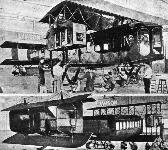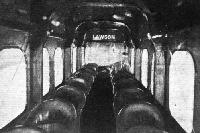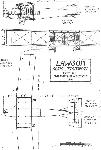
Описание
Страна: США
Год: 1919
Журнал Flight
Flight, September 11, 1919.
THE "LAWSON" AERIAL TRANSPORT
WE have received the following particulars of the latest American commercial aeroplanes, the Lawson "Aerial Transports," designed by Alfred W. Lawson, of the Lawson Airline Transportation Co., Milwaukee, Wis.
The accompanying drawings are of the Type C 1, to which our description mainly refers, whilst the photographs show the Type C 2, which has just been completed and put through its trials. The C 2, which, with a large fleet of the same type, is intended for a daily service between New York and San Francisco, differs from the C 1 only in some of the dimensions and the arrangement of the air-screws. These, it will be seen, are pushers in the C 1 and tractors in the C 2. The following description of C 1, therefore, will also serve for C 2.
The whole machine has been designed from a strictly commercial point of view, and all the details of its construction and performance characteristics take into consideration the safety and comfort of the passengers. It possesses a high degree of inherent stability, a very flat gliding angle, and a relatively high factor of safety. The manoeuvrability, both in the air and on the ground, is good, all the control surfaces being of generous proportions and well balanced.
The fuselage is built to accommodate 26 passengers, the seats being placed at windows on each side of the body, as shown in the illustrations, and an aisle between the seats allows passage from the front and rear of the cabin. On the port side of the cabin, forward of the wings, is a door of ample proportions to ensure easy entrance and exit, one of the pilots' seats being made to swing back out of the way. All the seats are of wicker construction, upholstered with green leather and provided with safety belts. They are secured to the floor, but are readily detachable, and sleeping quarters may be installed for a fewer number of passengers when cruising for considerable distances.
The interior of the cabin is finished in polished mahogany, and the floors are covered with carpet. The depth of the body is sufficient to allow one to stand up without stooping when walking through. The cabin is built up on box formers without transverse bracing, and is covered with veneer. The rear portion of the fuselage is of girder construction with veneer panel struts and wire bracing, and is covered with fabric. The longerons are of solid section ash in the cabin portion, and spruce at the rear.
The main planes, which have the U.S.A. 5 wing-section, are in seven sections, comprising one top and two bottom centre sections carrying the power plant, and the outer sections. The latter have a sweep back of 6° and a dihedral angle of 1°. The wings have a comparatively high factor of safety of 14, and are strongly braced internally and externally by double cables. The interplane struts are of deep streamline section wood. Balanced ailerons of wood construction are fitted to both top and bottom planes.
A large biplane tail is fitted having a cambered upper surface and a comparatively flat under surface. The fuselage terminates in a tubular steel stern post to which is attached the rear spar of the lower tail plane, and also the tail skid. The tail plane is adjustable. The rudders, of which there are three, and elevators are of the balanced type of wood and steel construction, mainly the latter in the case of the rudders.
Dual control is provided at the forward end of the cabin, the wheels being 18 ins. diameter, and mounted on columns carried by a transverse rocking shaft extending right across the body; the usual foot-bars operate the rudders. All control cables are duplicated. For night flying, electric lights are provided for the instrument-board, cabin interior and wings.
The landing-gear is composed of two pairs of 36 ins. by 8 ins. wheels, carried on large streamlined tubular steel struts. One pair of wheels is located under each engine in such a way as to take up evenly the landing shocks with a minimum of strain to the fuselage and wings.
Two Liberty engines, of 400 h.p. each, are installed, mounted on stout ash bearers, braced by steel tubes. They are completely enclosed by neat metal "bonnets," in the nose of which are mounted the radiators. Effective silencers are fitted, which add greatly to the comfort of the passengers.
The general specifications are as follow :-
Span, top and bottom 80 ft. (95 ft C 2)
Chord, top and bottom 9 ft. 6 ins.
Gap 9 ft. 3 ins.
Overall length 47 ft. 7 ins.
Overall height 14 ft.
Area of main planes
(including ailerons) 1.440 sq. ft.
Area of ailerons (4) 168 sq. ft.
Incidence of main planes 3°
Weight of machine fully loaded 12,000 lbs.
Speed 100 m.p.h.
Climb in 10 mins. 4,000 ft.
Ceiling 15,000 ft.
Gliding angle 1 in 8.
Fuel duration 5 hours.
Range 500 miles.
- Журнал Flight
Фотографии
-
Журнал - Flight за 1919 г.
Three-quarter front view of the Lawson "Aerial Transport," Type C 2.
-
Журнал - Flight за 1919 г.
Two views of the fuselage with centre sections and engines, of the Lawson "Aerial Transport."
-
Журнал - Flight за 1919 г.
The interior of the cabin of the Lawson "Aerial Transport."
-
Журнал - Flight за 1919 г.
THE LAWSON "AERIAL TRANSPORT," TYPE C 1: Plan, front and side elevations to scale.




